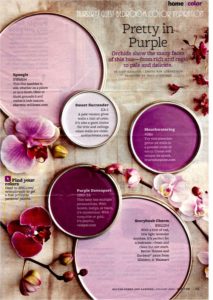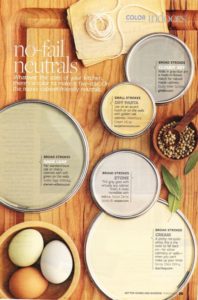This time of the year, is a good time to paint the interior of your home, not too hot to leave your window open. In a world where thousands of colors of paint can be yours for just $25 a gallon, it pays to consider the colors you want to live with. Remember that while there are thousands of paint chips at the store, there are only seven colors in the paint spectrum.

If you find yourself paralyzed at the paint store, unable to choose your color sample cards, look at the darkest color at the bottom of the strip. If you can live with the one at the bottom, you know you’ll like the middle and top, but if you choose by looking at the top, lightest colors, all the cards in that category start to look the same.

Where rooms are relatively featureless, painting an “accent wall” in a vivid hue where the others are white or neutral can add a dramatic, contemporary edge when the accent wall three shades darker.

Consider the ceiling the fifth wall of a room. Though sticking to “ceiling white” generally makes a space feel airy, a similar effect can be achieved by painting the ceiling a lighter shade of the wall color. Just take the paint sample card that has your wall color as the middle choice, then go one or two choices lighter for the ceiling color. The result will be a room that appears larger, because the contrast between wall color and ceiling color has been softened. In a small room, such as a bathroom, the ceiling can even be painted the same color as the walls to make it look bigger.

Once you have your colors in hand, consider the finish you’ll be using. Though today’s flat paints have increased stain resistance, conventional wisdom has long held that a satin (also called eggshell) finish is best for walls because it is scrubbable and doesn’t draw attention to imperfections. Semi-gloss and high-gloss finishes, it was thought, were best left to the trim, where they could accent the curves of a molding profile or the panels of a door. Today, however, finishes are also being used to create visual effects on the entire wall. Paint one wall in a flat or satin finish and the adjacent wall in a semi-gloss, both in the same color, and “when the light hits the walls, it creates a corduroy or velvet effect. Similarly, you can paint the walls flat and the ceiling semi-gloss to achieve a matte and sheen contrast. The ceiling will feel higher the lighter-more reflective it is. Keep in mind that the higher the gloss, the more sheen and the more attention you draw to the surface. Used strategically, color and gloss together can emphasize your interior’s best assets.

5 Common Color Mistakes
- Being afraid.
The world is divided into two groups—the color courageous and the color cowardly. The best way to get over that fear is to always start with a color you love—from a rug, a painting, a fabric. Then test it on the wall. If it’s too strong, consider asking your paint store to formulate it at “half-strength” to lighten it or to tone it down by adding grayer.
2.Putting too many colors on the walls.
Be aware of the intensity of the colors in a room.
- Putting too little on the walls.
If you think your room is boring, look at it in terms of the 60-30-10 rule that designers employ: Sixty percent of the color in a space generally comes from the walls; 30 percent from upholstery, floor covering, or window treatments; and 10 percent from accent pieces, accessories, and artwork. Translation: Liven up those white walls.
- Rushing the process.
The best way to find a color you can live with is to paint a 4-by-4-foot swatch on the wall and live with it for at least 24 to 48 hours, so you can see it in natural and artificial light.
- Forgetting about primer.
Priming ensures there will be no interference from the previous wall color.
